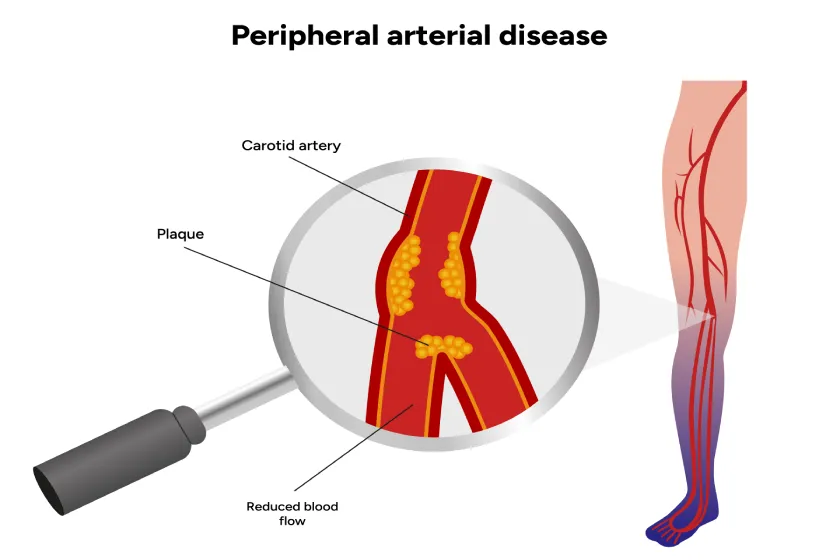
happens again. You start to wonder — is it just muscle fatigue or something more?
Leg cramps while walking are not always harmless. If you’re experiencing frequent pain in your legs when you walk, especially if it improves with rest, you might be dealing with something known as Peripheral Artery Disease, or PAD. It’s a condition that often goes undiagnosed but can have serious consequences if left untreated.
Let’s uncover what PAD really is, how it affects your legs, and why seeing a vascular surgeon in India could change everything.You’re walking to the grocery store or taking a short stroll after dinner when a cramp suddenly hits your calf. You stop, rest for a moment, and the pain eases. But the next time you walk, it
What Is PAD (Peripheral Artery Disease)?
Peripheral Artery Disease, commonly called PAD, is a circulatory condition in which narrowed arteries reduce blood flow to the limbs, most commonly, the legs. Just as clogged arteries in the heart can lead to heart disease, blocked arteries in your legs can lead to leg pain, numbness, and serious complications.
PAD develops when fatty deposits (plaques) build up in the arteries, restricting blood flow. Over time, this lack of circulation can cause pain during activity, skin changes, slow-healing wounds, and even increase the risk of limb loss or amputation.
Symptoms of PAD You Shouldn’t Ignore
PAD often begins silently but gradually shows symptoms that should never be ignored. The most common early warning signs include:
- Cramping in the legs during walking
- Pain in the calf, thigh, or hip muscles
- Numbness or weakness in the legs
- Coldness in the lower leg or foot
- Sores and ulcers on toes, feet, or legs that heal slowly
- A change in the color of your legs
- Weak or no pulse in your feet
- Shiny skin or hair loss on the legs
These symptoms of PAD can vary from person to person. Some may have no symptoms at all, while others may experience discomfort only during physical activity.
Pain in Legs While Walking (Claudication)
One of the hallmark symptoms of PAD is intermittent claudication — a cramping pain in the legs triggered by walking or activity and relieved by rest. Many people simply describe it as “pain in my legs when I walk.”
The pain is caused by insufficient blood flow to the muscles during exertion. As activity increases, your muscles demand more oxygen-rich blood. With PAD, narrowed arteries can’t deliver enough of it, leading to pain, fatigue, and cramping. This gets relived on rest.
Why Does PAD Cause Pain During Walking?
Think of your muscles like a car engine. They need fuel (oxygenated blood) to keep going. In PAD, the narrowed arteries limit blood flow, especially during activity. When you walk or climb stairs, your leg muscles struggle to get the oxygen they need. This leads to a buildup of lactic acid and other waste products, causing pain and cramping.
Once you rest, your muscles require less oxygen, and the pain subsides — temporarily. But as the condition worsens, the pain can start even at rest.
Who Is at Risk?
PAD can affect anyone, but certain factors increase your risk significantly:
- Age over 50, especially with other risk factors
- Smoking or a history of smoking
- Diabetes
- High blood pressure
- High cholesterol
- Family history of vascular disease
- Obesity
- Sedentary lifestyle
PAD is more than just a circulation issue. It’s a warning sign of widespread arterial disease, which may also affect your heart and brain.
Diagnosis: How Is PAD Detected?
Diagnosing PAD starts with a physical exam and a detailed discussion of your symptoms. A vascular surgeon in India, like Dr. Sumit Kapadia, may perform one or more of the following tests:
- Ankle-Brachial Index (ABI): Compares blood pressure in your ankle and arm to check blood flow.
- Doppler Ultrasound: Visualizes blood flow in your leg arteries.
- Angiography: Provides detailed images of your blood vessels using contrast dye.
- Blood Tests: Check for cholesterol, sugar levels, and other risk indicators.
Early detection is key. The earlier PAD is diagnosed, the better your chances of avoiding complications like ulcers, gangrene, or limb amputation.
PAD Treatment Options
PAD treatment focuses on improving blood flow and reducing symptoms. Depending on the severity, treatment may include:
Lifestyle changes
Quitting smoking, eating a heart-healthy diet, walking regularly, and managing blood sugar and blood pressure.
Medications
Blood thinners, cholesterol-lowering drugs, and medications to improve walking ability.
Minimally invasive procedures
Angioplasty, where a small balloon is used to open the narrowed artery, or stenting to keep the artery open.
Surgical options
Bypass surgery may be needed in severe cases to redirect blood flow around a blocked artery.
If you’re diagnosed with PAD, your treatment plan will be customized to suit your condition and lifestyle needs. The goal is not just symptom relief but also preventing heart attack or stroke.
Conclusion: Don’t Ignore That Walking Pain
A little discomfort while walking might seem harmless, but if it keeps happening, it’s worth paying attention to. PAD is more common than you might think, and it can sneak up silently, only revealing itself through subtle signs like walking and leg cramps.
Ignoring leg pain could mean missing the chance to catch PAD early and prevent more serious issues down the line. With proper diagnosis and a personalized peripheral artery disease treatment plan, you can regain your mobility, confidence, and long-term vascular health.
If you’re struggling with leg cramps while walking or any PAD in leg symptoms, don’t brush it off. Consulting a qualified vascular surgeon in India, like Dr. Sumit Kapadia, can be the most important step you take toward recovery.
Frequently Asked Questions (FAQs)
If your leg cramps consistently occur while walking and improve with rest, especially in the calves or thighs, it could be PAD and should be evaluated by a vascular specialist.
Cramps during walking are often caused by reduced blood flow to the muscles, commonly due to PAD. It’s essential to distinguish this from general muscle fatigue.
While PAD cannot always be completely reversed, it can be managed effectively through lifestyle changes, medication, and sometimes minimally invasive procedures or surgery.
If the pain is predictable, triggered by walking, and relieved by rest, it’s likely intermittent claudication from PAD. A Doppler test or ABI can confirm the diagnosis.
PAD can begin as early as age 40, especially in people with risk factors such as smoking, diabetes, or high blood pressure. Risk increases significantly after age 50.

Dr. Sumit Kapadia
MBBS, MS, MRCS, DNB-Fellow



